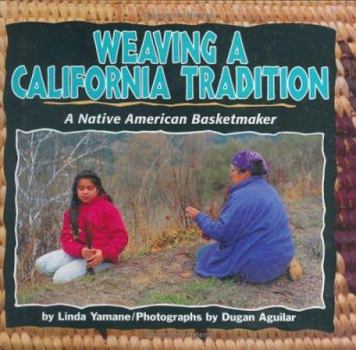Weaving a California Tradition: A Native American Basketmaker
Select Format
Select Condition 
Book Overview
Follows an eleven-year-old Western Mono Indian, as she and her relatives prepare materials needed for basketweaving, make the baskets, and attend the California Indian Basketweavers Association's... This description may be from another edition of this product.
Format:Library Binding
Language:English
ISBN:0822526603
ISBN13:9780822526605
Release Date:January 1996
Publisher:Lerner Publishing Group
Length:48 Pages
Weight:0.94 lbs.
Dimensions:0.5" x 9.7" x 8.4"
Age Range:8 to 11 years
Grade Range:Grades 3 to 6
Customer Reviews
1 rating
Fine account of California Indian life today, great photos
Published by Thriftbooks.com User , 27 years ago
This is the latest -- and one of the best -- of Lerner's unique "We're Still Here" series of Native American books for young people. The general structure of all these books is that they are written and photographed by tribal members. Each book follows a tribal young person -- here a girl, sometimes a boy -- of age from 11 - 14 through some daily life and some special activities. Contacts and knowledge of the tribal author always result in clear focus, accurate contemporary cultural portrayals, and bits of history interwoven in accurate and inoffensive ways. This book is perhaps Lerner's best to date. Author Yamane is a California Rumisen Ohlone, herself a basketweaver and one of the founders (and a current officer) in the large and very active California Indian Basketweavers' Association. Too, she is a talented and sensitive writer of another book -- Ohlone legends, painstakingly reconstructed from old recordings made in Spanish. She is able to convey -- clearly and interestingly -- the plant gathering, preparation, and weaving techniques that 11-year-old Carly Tex learns from her relatives. Photographer Aguilar has a tribally mixed heritage: California Maidu and Pit River, and Nevada Walker River Paiute; his extensive photography studies result in better-composed and (naturally) lighted color photos than are usual in this series, though none are amateur. We meet Carly's family and learn something of contemporary Mono life, most of it applicable to other small, surviving California Indian tribes. We attend a powwow with Carly and her sisters. Close-up photos and drawings show the traditional basketweaving techniques Carly is learning, and we see her first completed baskets. High point of the book -- as no doubt it was for Carly -- is her attendance at the annual California Indian Basketweavers' gathering, where traditional basketry is shown and judged by expert elders from many tribes. At the gathering, baskets are not just on show, they are used. Pictures and text show cooking of traditional acorn-meal mush in a watertight cooking basket, once the method by which all hot foods were cooked by California peoples. As in all this series, we also see that Indian young people, despite participation in interests and activities of their cultural heritage, are not quaintly isolated from modern life, as if in museum dioramas. Carly rides a bike, wearing typical pre-teen clothing, near her house, works with computers at school, hangs out with friends, plays European musical instruments (flute and piano). This contrasts sharply to how a competent but non-Indian writer handled basketry ("The Basketmaker and the Spinner") as an archaic bit of history centered on a fictional long-ago child, surrounded by antique tribal people wearing loincloths in a pre-contact-style village of bark houses. This book points up the fact that Indian writers can do better jobs on this kind of book, not because of some mystic notion of blood influence on writing, but





